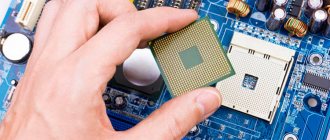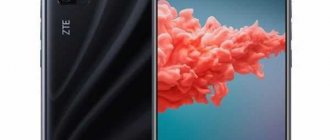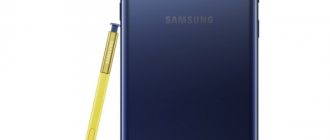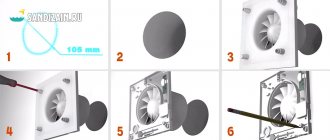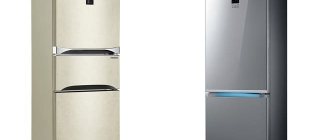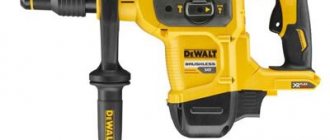Before Ryzen, you could only find AMD processes in computer stores on one platform - AM3. Of course, a little later its improved version appeared - AM3+, but in general they were both extremely popular, because they provided all the necessary options for lovers of powerful and fast PCs at a low cost.
Today, not everyone can afford the same Ryzen 1, 2 and 3 generations, so the issue with processors on the AM3 socket remains open. They can still be found, which indicates the relevance of the platform.
Now the processors of this platform are inexpensive, which means you have the opportunity to build an inexpensive PC that will be able to handle “heavy” games and software for the coming years. We will dedicate this article to them.
Which is the best processor for socket AM3
Now let's move on to which processors that support this socket will be the best choice for you.
Overview of AM3 and AM3+ sockets and rules for choosing processors
Socket AM3 is a platform for AMD processes, developed as a replacement for sockets AM2 and AM2+.
Unlike previous sockets, AM3 had hardware and software support for DDR3 RAM. In addition, this platform had a faster bus that supported HyperTransport technology. The fact that AM3 is largely similar to the previous platform can be understood by quickly looking at the changes.
- Conversion of chips to LGA packaging.
- Preservation of geometric dimensions.
- The number of CPU pins remains the same.
Since AMD was driven by the idea of compatibility and continuity, finding differences between the old (AM2) and new (AM3) sockets can be very difficult and can only be seen if you look very carefully.
Continuity and compatibility are what determined the success of the AM3 socket
Later, the AM3+ socket appears, which differs slightly from its “parent”. This is evident in the support for backward compatibility between AM3 and AM3+. However, to use an AM3 processor with an AM3+ socket, you must first update the BIOS to the latest version.
Important! Processors for AM2 and AM2+ cannot be installed on a board with AM3 support due to technical limitations. But you can do the opposite - by installing a processor for AM3 on a board that supports AM2 and AM2+, you can safely use it.
There are several visual cues that can help you identify your socket.
- Colors . AM3 is always painted white, but AM3+ is black.
- Labeling . AM3 has always had the same marking, and its improved version has undergone minor changes in marking - AM3+ is designated as AM3b.
Socket AM3 and its improved version have slight differences.
If hardware is not your thing, you can use software methods to determine the socket. For example, CPU-Z.
We’ll tell you now what you need to do with this program.
- Launch CPU-Z.
- Go to the Mainboard section
- Find the line with the manufacturer's name and model name.
After this, you can find the website of the motherboard manufacturer on the Internet, indicate your model and there you will see what platform for the processor is, and also find out what BIOS version you need for stable operation of your processor with the motherboard.
You can programmatically detect the socket version
How L3 Cache Size Can Affect CPU Performance
If we talk about the hardware component, what is noteworthy about AM3 is that the size of the third level cache has been reduced. And this raises the question: will everything become slower? The answer to this question lies in comparison.
To make it clearer, you can compare two processors of the same line. Let's take, for example, quad-core models, namely the Phenom II X4 810 and its improved version, the Phenom II X4 920.
Both models have a lot in common: the same technical process, the same clock speed, the same number of cores. The difference between them is only in the amount of cache memory. Speaking in specific numbers – 4 and 6 MB.
Cache memory is one of the important components of the processor, which means it needs to be given attention when choosing a processor.
The difference of 2 MB is a very insignificant figure, and therefore we cannot talk about a reduction in performance. A 2-5% drop is so insignificant that it can be ignored.
From this we can conclude that the 810 model is cheaper and the cache volume does not interfere with being on the same level with it. Another thing that gets in the way is the low clock frequency of the 810 model.
Energy consumption
The development of Phenom II processors took a long time. In an attempt to improve its power consumption, AMD has made several changes to outperform Intel models in this regard.
- First, a change in the CPU design made it possible to use not two, but four p-states, which helped reduce the core clock frequency to 800 MHz when idle. As a result, energy consumption was reduced, and significantly.
- In addition to the design, the energy saving mechanism . Bringing all cores to the same clock frequency made it possible to maintain high performance while increasing the number of p-states.
Let's take as a before/after comparison a processor like the Phenom X4 9950 Black Edition. It had a high heat output (140 W), which is why it could not be installed everywhere.
As soon as AMD switched to the 45 nm process technology, all CPUs decreased power consumption, the thermal package became equal to 125 W, and for weaker processors it was generally 95 W.
Energy consumption is an extremely important issue, because you need to calculate how much each PC component consumes, especially the processor
Everything you need to know about overclocking on the AM3 platform
Phenom II and its release once again sharpened attention to the topic of overclocking processors from AMD. The 45-nm process technology made it possible to increase overclocking potential, because when using an air-cooling system (ACS), four- and six-core processors supporting the AM3 socket are capable of reaching frequencies on average of 3.7-3.8 GHz. Some processors that came out later were capable of reaching 4 GHz.
Let's take the Phenom II X4 810 processor as an example. Using a motherboard on the AM3 platform, we overclock the processor and discover the following.
- Auto-overclocking (the so-called Turbo Core), if present in processor support, allows you to achieve the desired results in one click.
- If there is no such function, you should look for an unlocked multiplier . For processors with AM3 support, it is usually unlocked in the Black Edition.
- Overclocking involves using a different air cooling system . A stock cooler is only suitable for normal CPU use (maintaining the base clock speed.
As we said a little earlier, the average speed after overclocking is 3.7-3.8 GHz. This can be achieved by increasing the CPU supply voltage. Typically the shift is slightly more than 1 V.
Important! Manual overclocking, if you have never done it before, is better not to do it. All changes occur at your own risk.
In the presence of a non-free multiplier, as in the case of the Phenom II X4 810, overclocking is carried out by increasing the clock frequency of the generator. Its increase to 280 MHz, in general, is easily absorbed by the motherboard, which means there are no problems with increasing the processor clock speed to 3.64 GHz.
The following follows from this: overclocking processors in sockets AM2 and AM3 is absolutely the same, which means it can be done as we have just described.
Getting an overclock of 40% allows you to achieve an advantage on the part of the 810th processor compared to its counterpart in the form of the Intel Core 2 Quad Q8200, which can only be overclocked to 3.4 GHz.
Conclusion: the overclocked 810 will attract not only overclockers who want to overclock the processor to the maximum, but also ordinary people who crave a powerful PC.
Pre-top level processors 25-38 thousand rubles
Processors, the purchase of which will make you forget about upgrading a powerful gaming or workstation for five years.
1
Core i7 10700KF
Rating:5.0
- socket: LGA1200
- number of cores: 8 x 2900-4800 MHz
- L2/L3 cache size: 2 MB/16 MB
- RAM: 2 x DDR4 2933 MHz
- heat dissipation: 65 W
Average price: RUB 26,275
Core i7 10700KF is the best gaming processor in the price category of 25-38 thousand rubles: it copes with any virtual entertainment, does not heat up, runs perfectly, is 20% faster than its predecessor, and costs almost the same. Core i7 10700KF is an eight-core processor with an unlocked multiplier, designed for enthusiasts. It has high power consumption and a lot of settings - only experienced users can choose the optimal parameters. It differs from the Core i7 10700 by increased frequencies, energy appetite and heat dissipation. Built on a 10-core die with a pair of locked cores. After disabling power consumption limits, it is capable of operating at frequencies up to 4.7 GHz under load on all cores, but only for a short time. The frequency is quickly reduced to stabilize the temperature and thermal package at 65 W.
Gaming tests show an interesting picture: they don’t care what modification of the Core i7 10700 is used or whether power consumption limitation is enabled. The latest games are not able to load the processor so much that it consumes more than 65 W - for virtual entertainment, the power of the crystal is excessive. In the coming years, you won’t have to worry about a lack of productivity.
2
Ryzen 7 5800X
Rating:4.9
- socket: AM4
- number of cores: 8 x 3800-4700 MHz
- L2/L3 cache size: 4 MB/32 MB
- RAM: 2 x DDR4 3200 MHz
- heat dissipation: 105 W
Average price: RUB 34,780
Refers to elite processors, burdened with a multi-chip architecture. It consists of a pair of identical crystals with cores and a third one responsible for I/O operations. Such solutions are difficult to test and research due to their structural features. Offers excellent gaming performance reserves for the future. In toys, the Ryzen 7 5800X outperforms the previous i7 10700KF model, but is also more expensive. In fact, it has a larger reserve. The cost of one core of this processor is higher than that of its competitors.
The device is free from the disadvantage of previous models - significant delays in the interaction of cores. It consists of one CCD chiplet and one CCX complex. The Infinity Fabric bus in the model is used to exchange data between the CCD chipset and the memory controller and drives. The solution improves the efficiency of the L3 cache, making it available to any core. Increased delays in virtual entertainment do not play a special role.
3
Ryzen 7 3700X
Rating:4.8
- socket: AM4
- number of cores: 8 x 3600-4400 MHz
- L2/L3 cache size: 4 MB/32 MB
- RAM: 2 x DDR4 3200 MHz
- heat dissipation: 65 W
Average price: RUB 22,170
A representative of the third generation of Ryzen with high-frequency cores at an affordable price. It offers virtually nothing new, but it introduces fixes for predecessor problems that negatively affect performance. Engineers increased single-threaded (gaming) and multi-threaded performance, got rid of unpleasant features of the memory controller, and improved efficiency.
Delays in the interaction of kernels from different CCX complexes remain, but games are not applications where they have a significant impact on performance. Crystal has proven itself in creating multimedia content, modeling and solving other professional problems. Copes with streaming games in Full HD resolution at 60 FPS without frame drops. The Ryzen 7 3700X does not limit the performance of top video cards when running games in 4K. It lags behind the i7-9700K in terms of FPS by ~10%.
conclusions
The transition to the AM3 platform was not easy. Not everyone could take advantage of the benefits it provides, especially those who bought the first Phenom II models a long time ago - they do not support DDR3 at all. There were other pressing problems - for example, the refusal to work in dual-channel RAM mode.
Despite this, this platform showed its best side . Everything went smoothly and clearly at a low cost. Cheap motherboards increased the popularity of this socket, and therefore many interesting processor models appeared that support the AM3 socket.
In the future, AMD, of course, released other sockets, fixed problems with RAM, unlocked multipliers on its processors, and most importantly, developed Ryzen, which is now available in three generations. But without AM3 it wouldn't exist now.
In this article, we have compiled the best CPU options that support socket AM3. Now they are produced less frequently, so it is better to look for them on various online sites such as Ebay or Amazon, as well as in computer stores.
How we choose
Our team consists of a group of professionals, each of whom has many years of experience in the high technology field. So when we choose each of our product recommendations, we try to recommend only the best products that we would buy ourselves (if we haven't already).
When selecting the best AM3 processors, we've tried to take many factors into account, including performance, speed and price, to ensure you get the best value for your money.

